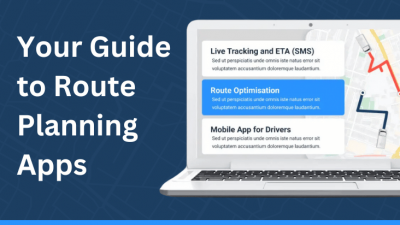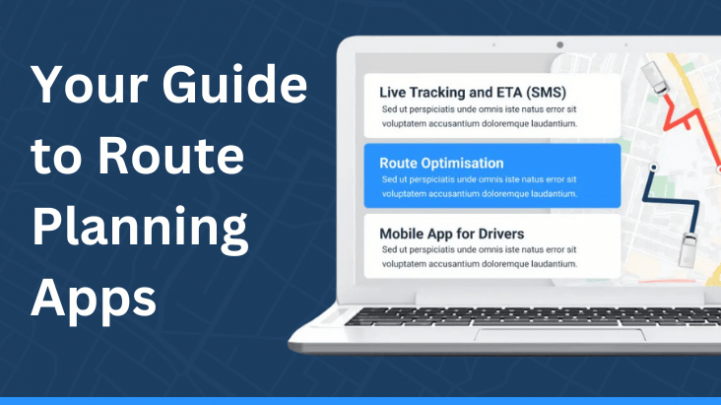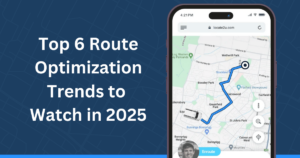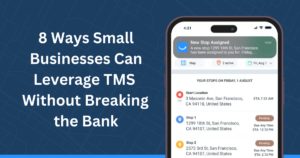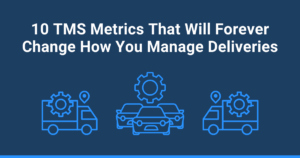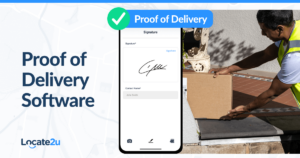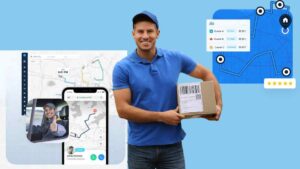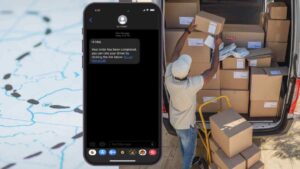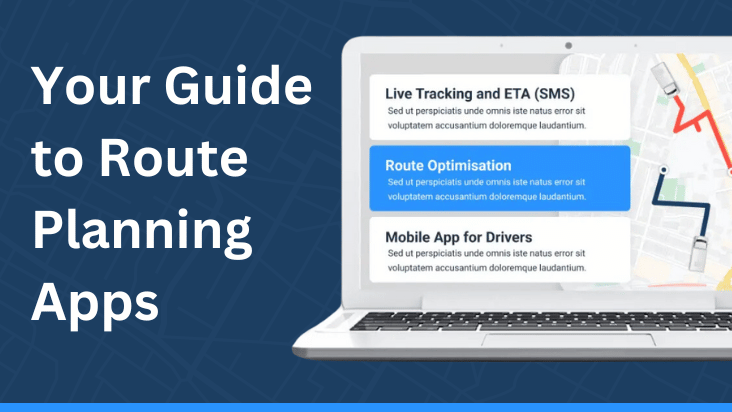
Efficient delivery operations are essential for modern businesses. Picture a logistics manager juggling multiple deliveries, driver schedules, and customer expectations without reliable software to help.
That’s where route planning apps come in.
It turns chaotic schedules into streamlined operations by organizing routes, cutting fuel costs, and boosting customer satisfaction.

In this guide, we’ll dive into what route planning apps are, their top features, the benefits they bring, and future trends shaping the industry.
Route planning versus route optimization?
Route planning is the process of creating a plan for visiting a set of locations This could be done manually or with the help of technology.
Meanwhile, route optimization is finding the most efficient or cost-effective way to complete that journey.
People have been planning routes for as long as they’ve been moving around the world.
What is a Route Planning App?
Route optimization software is designed to make the route planning process easier.

It builds the most efficient delivery or service routes by factoring in variables like traffic, weather, vehicle type, and driver schedules.
With these insights, businesses won’t have to worry about their drivers veering off-course. Optimized routes reduce the time drivers spend on the road, which also lowers costs.
Companies that rely on transportation – whether for goods, services, or people – use route planning apps to deliver efficiently and exceed customer expectations.
Route planning has been around forever. It even pre-dates Google Maps!
Benefits of a Route Planning App
Using a route planning app offers several advantages for businesses:
1. Increased Efficiency and Reduced Costs
Optimized routes minimize travel time, reduce fuel usage, and decrease wear and tear on vehicles.

By streamlining routes, businesses can save significantly on fuel and maintenance costs.
2. Enhanced Customer Satisfaction
Real-time tracking and accurate ETAs provide customers with reliable delivery information, reducing anxiety about arrival times.
When customers know when to expect their deliveries, it boosts trust and strengthens relationships.
3. Improved Time Management and Productivity
Automating route planning saves valuable time for managers and dispatchers, allowing them to focus on other important tasks.
This automation also reduces scheduling errors, helping drivers complete deliveries smoothly.
Key Features of a Route Planning App
A robust route planning app should offer a variety of features to maximize efficiency and control.

How? By predicting traffic holdups and weather conditions and using multi-stop models, live tracking links, and driver feedback.
1. Real-Time Traffic and Weather Integration
Incorporating live data – like as traffic updates and weather conditions – route planning apps can build routes that avoid traffic jams and severe weather.
This ensures timely deliveries and arrival times.
2. Multi-Stop Route Planning
For businesses handling multiple deliveries per route, multi-stop route planning ensures the most efficient sequence.
This helps businesses to save time and maximize the number of deliveries completed.
3. Live Tracking and Updates
Real-time tracking allows managers to monitor each driver’s location and progress.
This feature improves fleet oversight and enables quick responses to any issues. It also gives customers peace of mind by being able to track their deliveries.
4. Driver Performance and Feedback
Many apps include driver performance monitoring, providing insights into speed, fuel efficiency, and safety, which managers can use to guide driver training and improve overall safety.
Competitors in Route Planning Apps
1. Locate2u:
The Locate2u route planning app excels in comprehensive routing and tracking solutions.

Features like live tracking, real-time weather integration, and efficient multi-stop route planning make it ideal for businesses that want to streamline deliveries and increase customer satisfaction.
2. Verizon Connect:
Known for extensive tracking and routing capabilities, suitable for large fleets.
3. Samsara:
Popular for its real-time tracking and safety monitoring, it is ideal for medium-to-large businesses.
4. Onfleet:
Specializes in last-mile delivery, with robust real-time tracking and customer communication.
5. Routific:
Tailored for small-to-mid-sized businesses, with efficient route planning tools.
Case Study: GT Product Sales’ Journey to Growth with Locate2u
GT Product Sales, a leader in South Australia’s automotive spare parts industry, faced challenges as their paper-based delivery system could not keep up with their growing customer base.
Using Locate2u, GT Product Sales transformed their operations from manual processes to efficient digital solutions.
With Locate2u’s route optimization and proof of delivery features, GT Product Sales can now manage deliveries more efficiently.
Their drivers use the Locate2u app to collect orders from the warehouse, follow optimized routes, and deliver on time, providing customers with real-time tracking updates.
This transition from paper to digital has boosted productivity and allowed the company to scale operations smoothly.
How to Choose the Best Route Planning App
Choosing the right route planning app depends on several factors:
1. Assess Your Business Needs
Consider the size of your fleet, delivery frequency, and any specific requirements, such as multi-modal transportation.
An e-commerce business may prioritize multi-stop routing, while a field service business may focus more on real-time tracking.
2. Look for Scalability
As your business grows, your software should be able to handle increasing demands.

Look for apps that offer seamless integration with ERP and WMS systems to support your operations as they expand.
3. Prioritize Ease of Use
The app should have a user-friendly interface that’s easy for your team to adopt.
Reliable customer support also ensures you can troubleshoot issues quickly and keep operations running smoothly.
Future Trends in Route Planning Apps
As technology advances, route planning apps are evolving to offer even more capabilities:
1. AI and Predictive Analytics
AI helps predict potential delays, optimize fuel consumption, and adjust routes based on new data in real time.
Predictive analytics enables proactive planning, helping businesses stay ahead of potential disruptions.
2. IoT Integration
The integration of IoT devices allows for real-time data collection from vehicles, providing insights into vehicle conditions, driver behavior, and route accuracy.
This real-time feedback enhances decision-making and operational efficiency.

3. Eco-Friendly Solutions
With an increasing focus on sustainability, route planning apps are integrating eco-friendly features, such as EV routing and fuel-saving algorithms.
These options help businesses reduce their carbon footprint and appeal to environmentally conscious consumers.
FAQs on Route Planning Apps
Q: What is a route planning app?
A: A route planning app is a software solution that creates efficient routes for deliveries or services by considering factors like traffic, weather, and driver schedules.
Q: Can Locate2u integrate with existing business systems?
A: Yes, Locate2u offers integration options that work with your existing systems for smooth operations and data management.
Q: How does route optimization reduce costs?
A: Optimized routes save on fuel, reduce vehicle wear and tear, and allow drivers to complete more deliveries, improving overall efficiency and reducing costs.
Final Takeaways on Route Planning Apps
Route planning apps are essential for businesses seeking to improve delivery efficiency, reduce operational costs, and enhance customer satisfaction.
With features like live tracking, real-time traffic updates, and driver performance monitoring, these tools offer comprehensive solutions for managing complex logistics.
As technology evolves, route planning apps will continue to advance, integrating AI, IoT, and eco-friendly options that provide businesses with powerful ways to optimize and scale their delivery operations.
About the author
Cheryl has contributed to various international publications, with a fervor for data and technology. She explores the intersection of emerging tech trends with logistics, focusing on how digital innovations are reshaping industries on a global scale. When she's not dissecting the latest developments in AI-driven innovation and digital solutions, Cheryl can be found gaming, kickboxing, or navigating the novel niches of consumer gadgetry.

